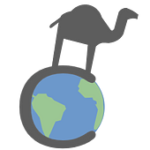When the Water Runs Dry: Bolivia’s Struggle With Scarcity
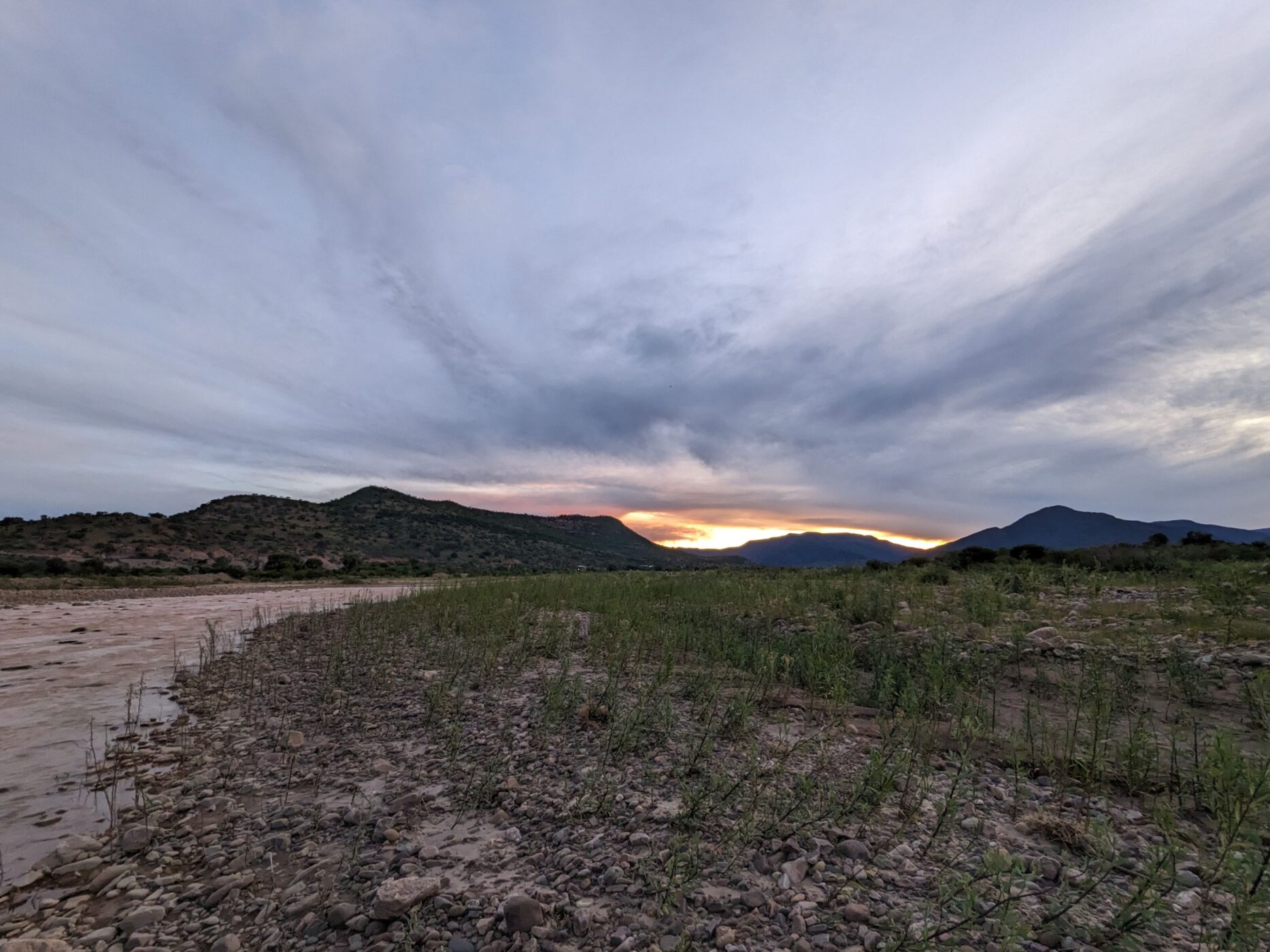
Visiting areas of water scarcity in South America has underscored the value of the “liquid gold” that sustains all life.
Water from the River
Mizque, Bolivia — It isn’t raining hard yet, but the drops falling on our cabin’s tin roof multiply the sound. Soon the clouds sigh and release more of their load. The water bangs like a thousand tiny hammers on the metal, walling us off from the rest of the farm in an impenetrable sound barrier.
It is unusual to have this much rain in March, which is the tail end of the rainy season in central Bolivia. “You never know,” warned one of our hosts at the permaculture farm where we’re volunteering, “if this rain will be the last we have in nine months.” Yet each likely-last rain is followed by another. The rainy season started late this year (January instead of November) and, it appears, will end late too.
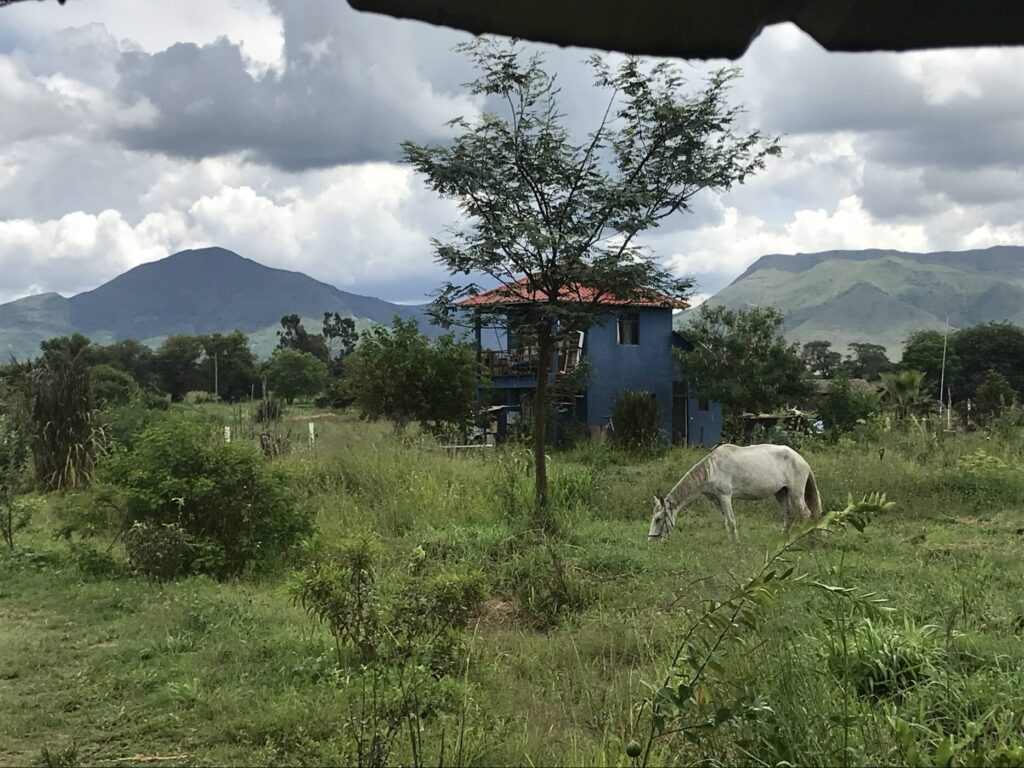
For the surrounding Quechua-speaking farmers, this is messing with their planting schedules. Don Hugo next door had his fields plowed by machine to prepare to plant onions the following day. Then it rained. The day they are supposed to plant, we visit his and Doña Adela’s cowshed to drink some fresh milk. “How is the rain affecting your plans?” we ask.
“If it doesn’t rain more, we can still plant tomorrow. If it does, we’ll have to re-plow the fields,” Doña Adela replies. The next day it rains.
With the distinct rainy and dry seasons in this part of the world, water comes in feast-or-famine cycles. Constant downpours for three months bring too much water at once, which flows off the land into rivers. Then the rain clouds disappear for the rest of the year, rivers slowly run dry, and cracks form in the thirsty ground. The sun acts as a natural kiln, baking the mud into hard, brittle chunks.
The farmers, who are all indigenous except for our hosts, divert water from the main river through community-maintained canals to their fields. Each family gets their allotment: 45 minutes twice a week which dwindles to once a week as the river levels drop.
Then the river runs dry, and they must hope that their crops have grown sturdy enough by then to survive until harvest.
Decades ago, when river levels were higher, the water never ran dry and they were able to get three annual harvests. Today, between the rainy season and the subsequent months, when they rely on the river for irrigation, the farmers are able to get two harvests a year. In the hills surrounding Mizque valley, water is even scarcer without easy access to the river. Up there, farmers only eke out one harvest per year.
Water from the Tap
Back home in Chicagoland, the thought that water could run out never once crossed our minds. We turn on the faucet to wash the dishes, or the side spigot for filtered drinking water. Water for laundry or the garden also comes from the city, which draws from deep and shallow aquifers nearby. I’ve never thought to check whether the aquifer levels have changed through the years, as the population has grown and more water is sucked out each year.
What we have noticed is the price. Just last year the city almost doubled its rates. They said they had held them steady for years but the hike was necessary for them to maintain the system. Whereas before we were paying about $100 every two months, now the bill has jumped to over $200. It was a shock.
To the east, municipalities draw from Lake Michigan. On the shore looking out, the placid blue stretches to the horizon. It could be the sea. Water around here seems abundant and endless. How could it ever run out?
Water Harvesting
Back on the farm, our host is pleased with the rains, unlike his neighbors. He has built a pond, swales (basically trenches) and a well on his two acres. He farms as a hobby rather than out of necessity. “Look at how the rains are recharging the groundwater,” he remarks, pointing proudly to the pooled water all over his property. To me, all this looks like a breeding ground for mosquitoes, my archenemies.
Groundwater recharging turns out to be a whole-morning topic in the holistic permaculture course we are taking on the farm with a few other volunteers. As the soil gets depleted from deforestation and unsustainable farming practices, it holds less and less water. The rains, instead of soaking into the ground and replenishing the water table, end up running off the land. This becomes a problem when too much runoff causes floods, which sweep off even more of what precious spongy topsoil remains. It’s a vicious cycle.
“Slow. Spread. Soak.” For our host, this is the mantra behind the curving gashes in his land, which to his neighbors look like needless occupation of crop space. Until we figured out the lay of the land and the location of the swales which spring up on an unsuspecting visitor walking through the grass unawares, we had a few wet shoes.
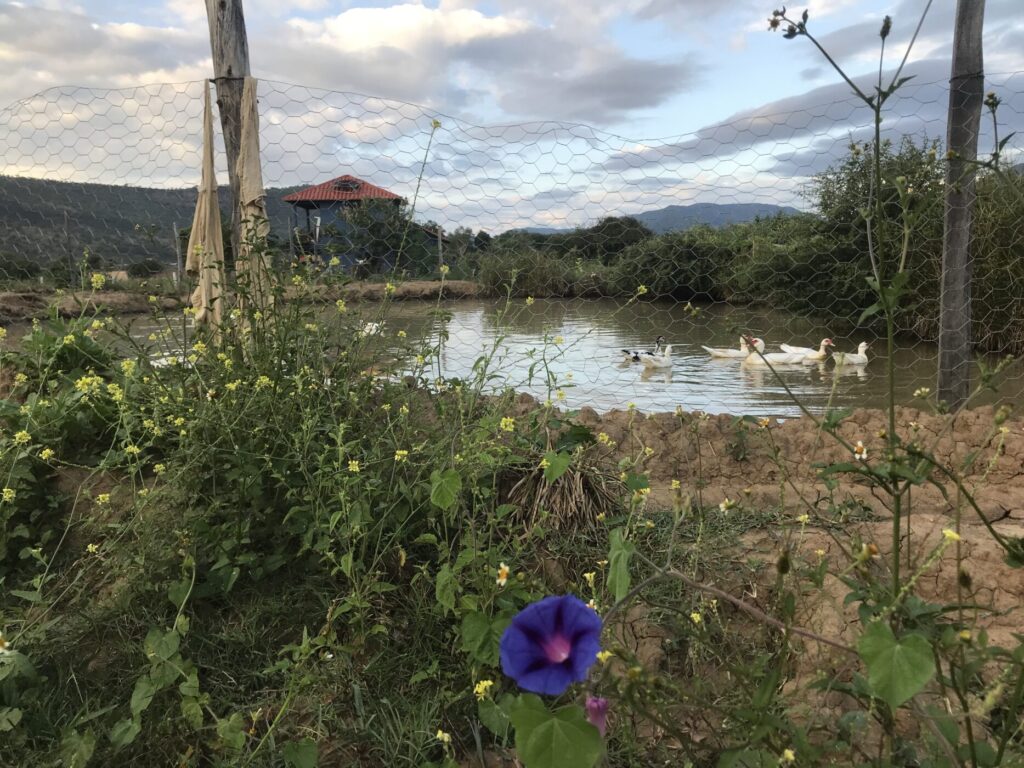
The technical term for these water (and human) traps are Continuous Contour Trenches. They are dug along land at the same level (hence they follow the contours of the land) to slow water that would otherwise run downhill and off a property. These swales, and the pond which houses a family of very happy free-range ducks, allow the rains to sink slowly into the groundwater below, which then charges the well. “Water harvesting,” our host declares. It’s the foundation of his plan to live independently off of his little plot of earth.
Who Does Water Belong To?
In the U.S., some states have made rules against water harvesting, such as through rainwater collection barrels. Nearby farmers have complained that this diverts much-needed water from their crops, especially in water-scarce areas. Which raises a big, gnarly question: Who does the water belong to?
If the water lies below the surface of land you own, is that little quadrant of water in the aquifer yours? Is it ok if your factory leaches a bit of radioactive waste into the water below your property (something that happened in my community of West Chicago, which I reported on here), since it’s your property, even if it ends up contaminating the whole aquifer?
If you are an avocado agribusiness in Chile, is it okay that you have more money and can buy up all the water in an area to nourish your trees while the nearby towns run dry?
If you are an farming community in the valley next to Cochabamba, Bolivia, a city of 800,000, how can you fight a construction company building a dam to divert hillside runoff, which you and your ancestors have depended upon, to the city, which each year grows and needs more and more of these precious droplets?
And what if, in Cochabamba, the government attempts to sell the city water system to a foreign investor? What if the foreign investor raises water rates to a quarter of your monthly wages because they say they need the money to extend lines out to father-reaching neighborhoods?
These are some real-life situations that we have encountered in our year-long travels through South America. In most cases, as you may imagine, the big business got the better end of the deal. The Cochabamba water wars were the exception. After Aguas del Tunari (a consortium ultimately controlled by the U.S. engineering company Bechtel) bought the city’s system, their rate raise caused a months-long protest throughout the city, eventually pushing the government to cancel the contract. The company later sued the Bolivian government for defaulting.
Today, Cochabamba’s water supply is still run by SEMAPA, the government water unit that was responsible before they tried to transfer rights to Aguas del Tunari. But access to clean and safe water is still an issue for thousands of Cochabambinos who live on the hillsides skirting the city. City pipes haven’t reached some of these neighborhoods, so they have to buy water by the truckload from dubious sources. Some communities have gotten lucky enough to receive nonprofit support in digging their own wells. These communities then pool together to maintain their neighborhood water system. It’s a third option between state-run water (which is often corrupt and has historically not reached some of the poorest communities), and foreign-controlled water, which feels to Bolivians like “leasing the rain.”
Water Activism
It is March 22, 2023. We have left the farm in Mizque and are now staying on the 11th floor of a high rise in Cochabamba, on the edge of Plaza Colon. Each day the boys look down into the plaza and see what’s happening. There’s always something, from people releasing dozens of pink balloons to families feeding pigeons. Today, the plaza is filled with people gathering in groups with posters and blue balloons, bands warming up, and lines forming. Is it a parade? A protest? We squint at the signs, which all share the word “AGUA.” It’s World Water Day!
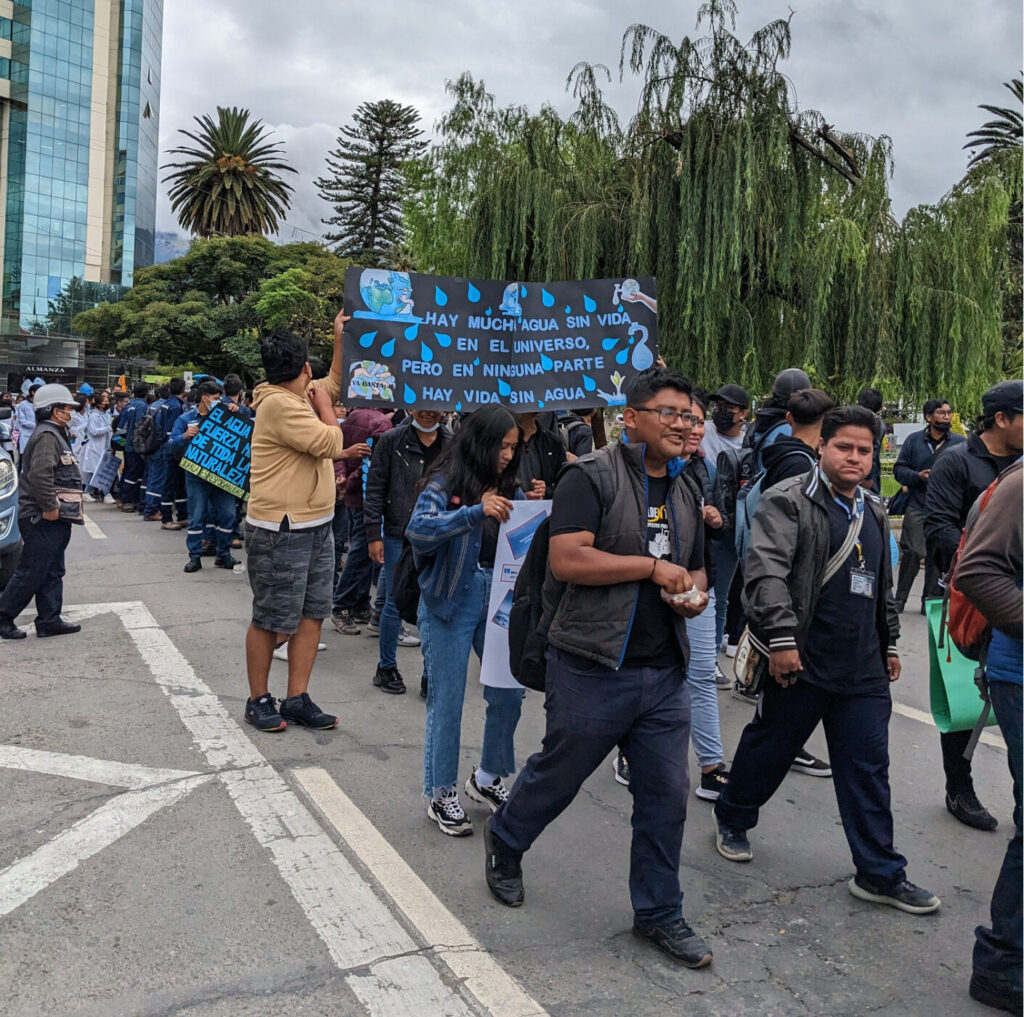
“Agua es la fuerza matriz de toda la naturaleza,” proclaims one sign — water is the maternal force of all nature. “Hay mucha agua sin vida en el universo, pero en ninguna parte hay vida sin agua.” — There is much water without life in the universe, but in no part is there life without water. “Se celebra con el objetivo de crear conciencia sobre la importancia de cuidar llamado el ORO líquido para la VIDA.” — we celebrate with the objective of creating consciousness around the importance of taking care of this liquid GOLD for LIFE.
I haven’t heard of World Water Day until this year. Back in the midwestern U.S., having abundant, safe water is not a concern for well-off communities. However, stories like those coming out of Flint, Michigan reveal that even in a so-called developed country, people still suffer from lack of clean water. The inequities are glaring when you see $4.29 bottles of Fiji water sold in stores while nearby mothers worry about the tap water their children use to brush their teeth.
On the website Dollar Street, you can see snapshots of everyday families across the globe at varying income levels. In Bolivia, we “visited” three families whose monthly incomes ranged from $180 to $265. We watched a video of one mother washing clothes in a dribbling pipe over a ditch. Another family didn’t have running water but collected buckets of glacier runoff for their daily needs. Another family pays 10% of their income for water (which is probably trucked to them).
Even with the rate hike in our hometown, we were still only paying maybe 3% of our monthly income for water. Our host at the Mizque farm scoffed at the amount we pay. Clean and safe water, he and many believe, is a basic human right.
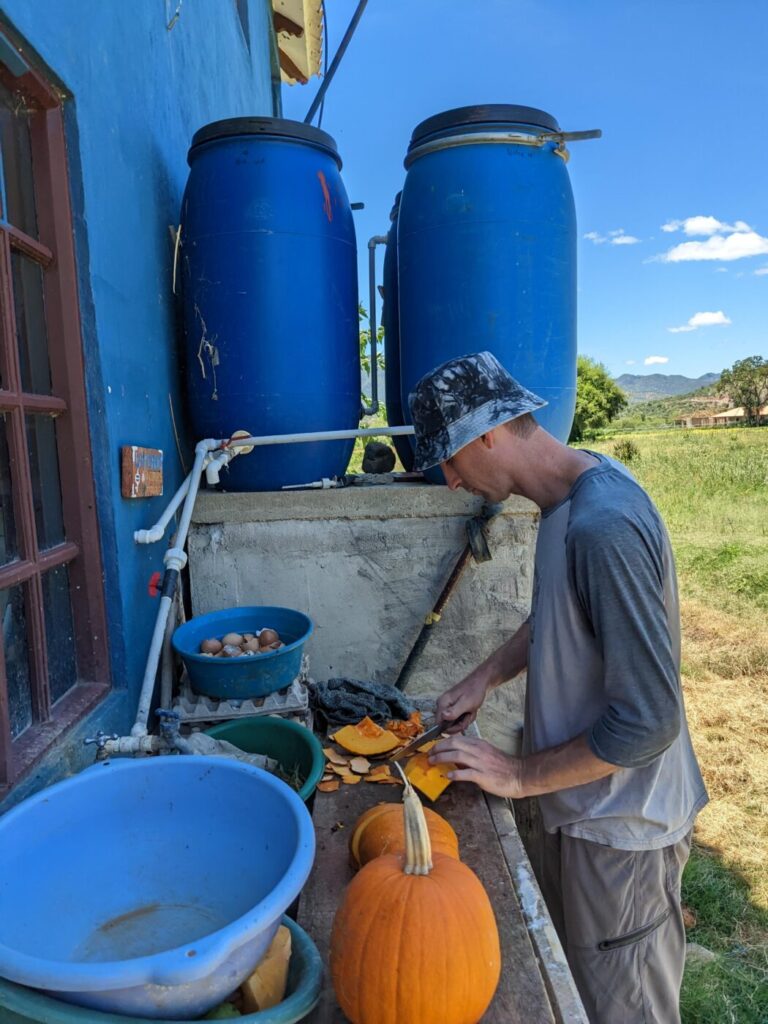
On the farm, they’ve installed a 4-barrel filter of sand, rocks, activated carbon, and UV light to treat the water they pipe from the city. Tap water in Bolivia can’t be trusted for drinking. I’m sure if water gets privatized in Mizque, our host will be the first to hop off the system and switch fully to his “harvested” supply in the ground. His techniques are already paying off, with his land remaining more humid and green for longer in the dry season. He’s hoping to convince an upland community to buy into these techniques as a larger demo site and eventually win over the entire region to practices that recharge the groundwater.
When we return to our life in the Chicago suburbs, I’m going to look into installing a rainwater collection barrel. I’m going to keep converting more of our little quarter-acre plot to native plants, whose roots go deeper to retain rainwater. We may not need these practices currently, but I want to do my part to create water abundance and resilience in our community. Having experienced the preciousness of water during our South American travels, I want to treasure every drop.






